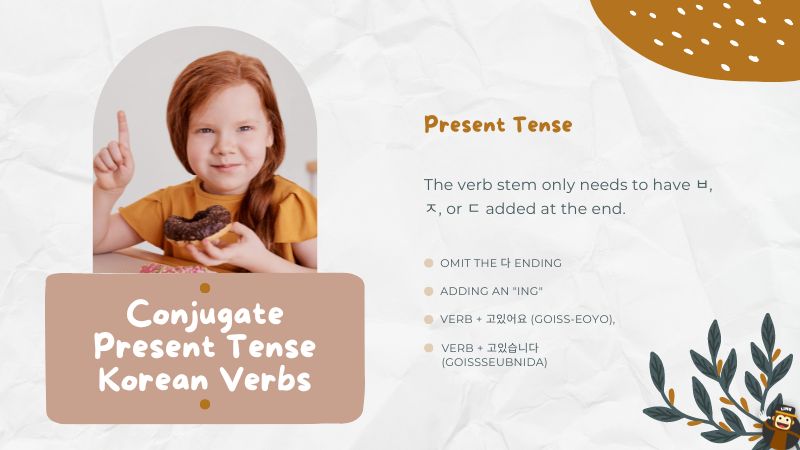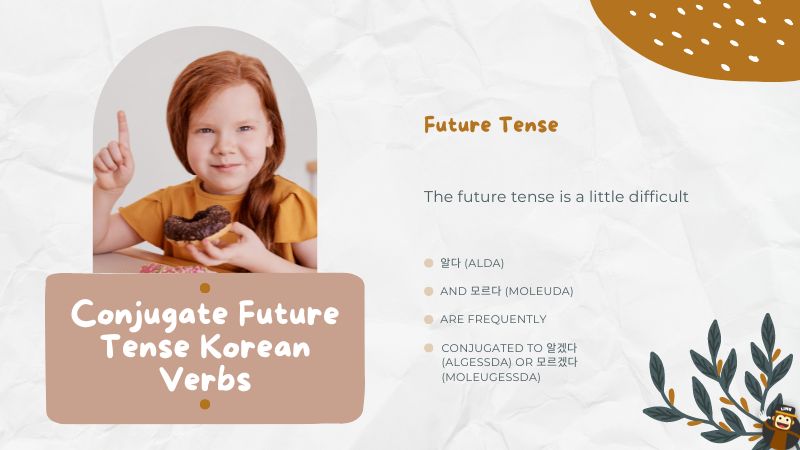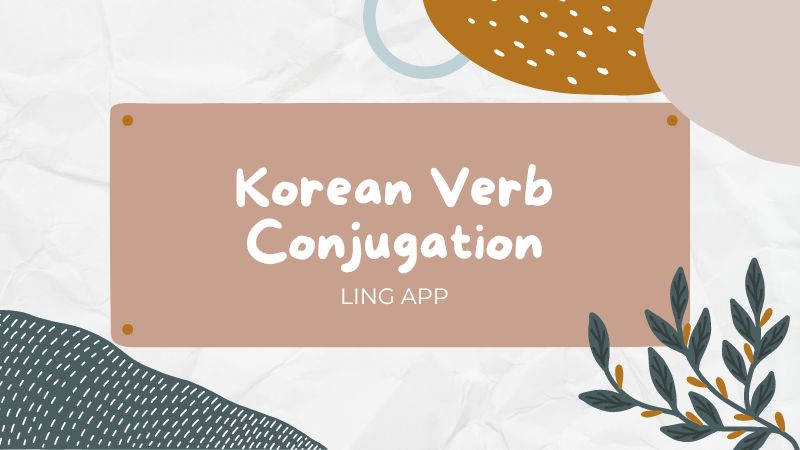Do you want to master how to conjugate Korean verbs? In that case, you’ve found the proper website! We’ll talk about the many Korean Verb Conjugations in this blog article. A list of typical Korean verbs and their matching conjugations will also be provided. So without further ado, let’s get started!
Korean Verb Conjugation
You should learn and memorize as many distinct Korean verb conjugations as you can because they make up the majority of sentences in that language. Korean has an entirely different Korean alphabet and grammar than English. Also, I have some excellent news for you! Korean has substantially simpler verb conjugation than many other languages.
The first thing you should know about Korean grammar is that it differs from English or Romance languages in terms of sentence construction. Although Korean verb conjugation is more simple than English, politeness in Korean is more difficult to master than in English.
You don’t need to bother about conjugating Korean words into the first, second, and third person. When the conjugation begins with a vowel, verbs that end in “으” are conjugated differently from other verbs. In essence, the vowel that begins the conjugation takes the role of “ㅡ”.
The verb is conjugated normally when the first consonant of the conjugation is a consonant. A vowel must come first in the conjugation. The verb must also finish in the vowel “으” rather than a consonant, for this irregular conjugation to occur, for example, 늦다 (neujda) “late” is conjugated normally.
Verbs In Korean

In Korean grammar, verbs play a significant role in speaking. When you first begin, learning Korean verbs may seem difficult. There are numerous conjugation rules to follow, including honorific verbs, verb stems, and verb endings following tenses like past, present, and future. You can, however, learn them in a variety of ways.
In Korean, adjectives serve to alter nouns, they are often referred to as descriptive verbs. This is because verbs make up the majority of them.
They are employed to describe individuals, objects, occasions, or experiences. A Korean adjective, however, can never serve as an action verb. It may come from a verb. For example; 기쁘다 (gippeuda), means “to be glad, happy”
Verb Forms
A verb is known as 동사 (dongsa) in Korean. They have four different forms of verbs namely, copula verbs, existential verbs, descriptive verbs, and active verbs. Each of these verb tenses is constructed from a verb stem and a suffix.
No gender is assigned to Korean verbs, and the verbs are not conjugated according to the topic. Instead, Korean conjugation is based on the person you’re speaking to and how much respect is appropriate. So, there is no need to change the verb’s conjugation to match the subject.
One thing that makes it special is that you can create your own straightforward Korean sentences once you have a sizable verb vocabulary and understand how to conjugate them. A subject is not necessary for a Korean verb to stand alone. When conjugated correctly, a Korean verb can form a complete sentence.
Korean Regular Verbs
Korean regular verbs are referred to as 규칙동사 (gyuchigdongsa). Conjugating them is simple. This implies that when you need to conjugate a verb, they simply follow the rules for doing so. You must become familiar with the various Korean verb conjugation patterns in order to accomplish that.
Korean Irregular Verbs
In Korean grammar, irregular verbs are referred to as 불규칙 동사 (bulgyuchig dongsa). When they are conjugated, they alter their spelling or shape. They typically contain 받침 (batchim). They are categorized based on the 받침 (badchim) they possess. It’s crucial to understand, though, that not all verbs with 받침 (badchim) in them are irregular.
When adopting a particular verb conjugation pattern, Korean irregular verbs typically have special rules. Adjectives in Korean are also affected by this description. Here are a few examples of the several irregular verbs in Korean. The dictionary form of these verbs is also available.
- 걷다 (geodda), means “to walk”
- 로드 (lodeu),means “to load”
- 듣다 (deuda), means “to listen”
“To Do” In The Korean Language
In the Korean language, the word for “To Do” is verb 하다 (hada). This verb is regarded as a common verb. These are referred to as (hada) verbs and are frequently found in numerous Korean nouns.
Many verbs in Korean finish in the letter 하다 (hada), which indicates” to do”. Numerous nouns can be transformed into verbs by the word 하다 (hada),” such as the noun 청소 (cheongso) “cleaning”. You only need to add “하다” (hada) to create the verb 청소하다 (cheongsohada) “to clean.”
Words that are nouns are typically converted to verbs by adding the verb하다 (hada). For instance, the words 걱정하다 (to worry), 공부하다 (to study), and 노래하다 (to sing). These words become nouns when 하다 (hada) is removed from these words; 걱정 (worry), 공부 (study), and 노래 (song).
How Many Conjugations Are There In Korean?
There are 40 fundamental verb endings, but when all of them are added together, there are more than 400 verb endings. They are made up of several Korean grammar categories, including honorifics, voices, and the various tenses (past, present, and future tense).
How Important Is It To Learn Korean Conjugation?
The Korean verb conjugation is crucial to master when learning the language, particularly Korean grammar. It establishes the tenor, tone, and meaning of your phrases, all of which are fundamental components of communication as we previously said.
Koreans place a strong premium on courtesy, even in their language. Korean verb conjugation will enable you to address someone with respect and courtesy. Knowing the various conjugations will make it simple for you to convey and sound courteous and polite.
How Do You Conjugate Korean Verbs?
The verb stem, the dictionary form, and the informal polite form are all used to conjugate Korean verbs. When conjugating a verb in Korean, the is removed from the verb stem or the word’s dictionary form before the proper conjugation patterns are added. The verb tense affects the conjugation patterns (past tense, present, and future).
The past tense is used to talk about things that have already happened, the present tense is used to talk about things that are happening right now or soon, and the future tense is used to talk about things that will happen in the future.
Let’s take the following words:
- 듣다 (deuda), means “to hear”
- 놀다 (nolda), means “to play”
- 울다 (ulda), means “to cry”
These verbs are considered common because they may be easily conjugated using the many Korean verb tenses. The letter 다 is deleted, and the proper conjugation is added while taking into account the verb’s last vowel.
Adjectives in Korean are also affected by this description. It’s important to remember that verbs are conjugated according to speech levels as well. There are a number of honorific conjugations.
Basic Rules Of Conjugation
There are a few Korean conjugation rules to bear in mind when changing Korean verbs’ tenses.
- First off, subject nouns or Korean pronouns are always followed by Korean verbs. For instance, you might use “I am having dinner,” you would say “나는 저녁을 먹고있다” (Naneun jeonyeog-eul meoggoissda).
- Secondly, Korean verbs always take on the same ending regardless of the subject. So, if you wanted to say “you are having dinner,” you would say “너 저녁 먹고 있어.” (neo jeonyeog meoggo iss-eo).
Verb Endings
Depending on the person you’re speaking to, Korean verbs do alter. Due to the very hierarchical nature of Korean society, respect for others is required of you. You must adjust the way you conjugate verbs and add honorifics to some terms. Koreans accomplish this in part by using verb endings.
Depending on whom you are speaking to, the Korean language has various degrees of formality. There are three main types of speech. Examine them with the verb 가다 (gada), “to go”.
Casual verb endings: 가다 → 가 (ga) means, Go
Polite verb endings: 가다 → 가요 (gayo) means, Go
Formal verb endings: 가다 → 갑니다 (gamnida) means, Going
Since they are the most appropriate in every circumstance, you’ll employ polite verb endings the most frequently. When speaking to peers your own age or younger, informal language is utilized. Elders, employers, and others in positions of more power should use formal speech.
Conjugate Present Tense Korean Verbs

You can omit the 다 ending and substitute the proper formality ending to conjugate Korean verbs in the present tense. Because you don’t have to worry about the final vowel, there is less to consider in this situation. The verb stem only needs to have ㅂ, ㅈ, or ㄷ added at the end.
The present continuous tense can be used to discuss an action that is still in progress. This tense is created in English by adding an “ing”. For instance, the verbs “eat” and “read” would become “eats,” “drink” and “drinks,” respectively.
| Casual Formality Verb | Verb + 고있어 (goiss-eo), means “I’m standing” |
| Low Formality Verb | Verb + 고있어요 (goiss-eoyo), means “I’m sleeping” |
| High Formality Verb | Verb + 고있습니다 (goissseubnida), means “I’m crying” |
Conjugate Past Tense Korean Verbs

The past tense of a verb has slightly more sophisticated conjugations than the present tense. To do this, you must once more focus on the final vowel or consonant of the verb stem.
Similar to what you said in the present tense. You add 았다 (assda), which means “was” to the verb stem if the verb’s last consonant is ㅗ orㅏ. The verbs “eat,” “drink,” and “read,” for instance, would change to “ate,” “drank,” and “read,” respectively.”
If the last vowel is not one of those ㅗ or ㅏ, you can add 었다 (eossda). Some verbs with vowel endings combine, much like present tense verbs. For example: 가다 (gada) + 았어요 (ass-eoyo) becomes 갔어요 (gass-eoyo), not 같았어요 (gat-ass-eoyo).
| Casual Formality Verb | Verb + 았어 (ass-eo), means” ok” |
| Low Formality Verb | Verb + 았어요 (ass-eoyo), means “I did” |
| High Formality Verb | Verb + 았습니다 (assseubnida), means “was” |
Conjugate Future Tenses Korean Verbs

Compared to the previous other tenses we’ve studied, the future tense is a little difficult. The future tenses can be expressed in a variety of ways. We won’t get into the specifics of each conjugation in this article; instead, we’ll concentrate on the way that future actions are typically discussed.
It would be wise to keep in mind that the words 알다 (alda) and 모르다 (moleuda) are frequently conjugated to 알겠다 (algessda) or 모르겠다 (moleugessda). However, we won’t make any example sentences at this time because they would be too complicated. These two words are usually employed to represent knowledge or ignorance in the present tense, despite the fact that they are conjugated to the future tense.
Drop the ending 다 (da) from the verb and add ㄹ (L) if the verb ends in a vowel or 을 (eul) if it finishes in a consonant to produce the future tense. Additionally, you don’t have to add ㄹ anything to verbs with an ending.
Regardless of whether the verb stem ends in a vowel or a consonant, adding 겠 (gess) to the end of the verb stem is how you conjugate verbs in the future tense. For example, the verb 먹다 (meogda), “eat” would become 먹을 거에요 (meog-eul geoeyo)“will eat,”.
| Casual Formality Verb | Verb + ㄹ (L) or 을거야 (eulgeoya), means “I will” |
| Low Formality Verb | Verb + ㄹ (L) or 을거야 (eulgeoya), means “I will” |
| High Formality Verb | Verb + ㄹ (L) or 을거야 (eulgeoya), means “I will” |
Korean conjugation is actually relatively straightforward as compared to many other languages, especially English. It adheres to a set of rules and hardly ever breaks them. You’ll be well on your way to conjugating phrases in different tenses in Korean if you have a firm grasp of the aforementioned guidelines.
Don’t let it stop you from using the Korean you’ve learned in the real world! Start mastering Korean verb conjugation right away!
Your Korean Proficiency Has Increased!
We Hope Visiting our website makes your life easier and helps you understand the rules. If you immerse yourself in Korean literature, the rules will soon become second nature. Korean verb conjugations are quite simple when compared to many other languages. You can quickly master Korean verb conjugation if you frequently study and practice.
Wrapping Up

Now that you have completed Korean verb conjugations, you are prepared to begin using them in your Korean studies and putting your Korean skills into use on a daily basis. You can gradually become fluent in Korean verb conjugation. Sign up and find out how much more you can study anywhere, anytime with the Ling App. What are you waiting for? Download the Ling App from the Google Playstore and App Store and start Learning Korean now! You can do it! 할 수 있어요 (Halsu Isseoyo)
















